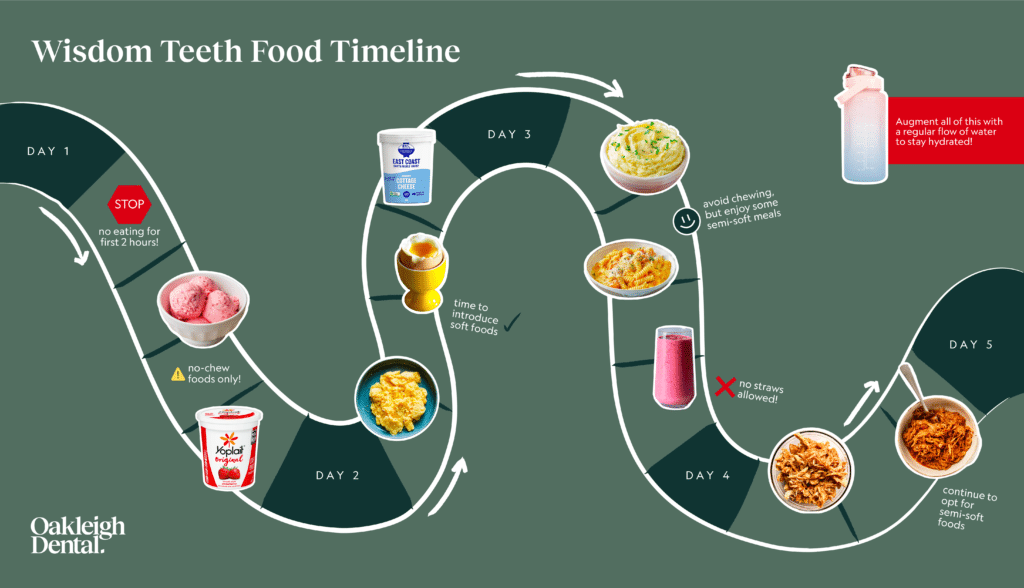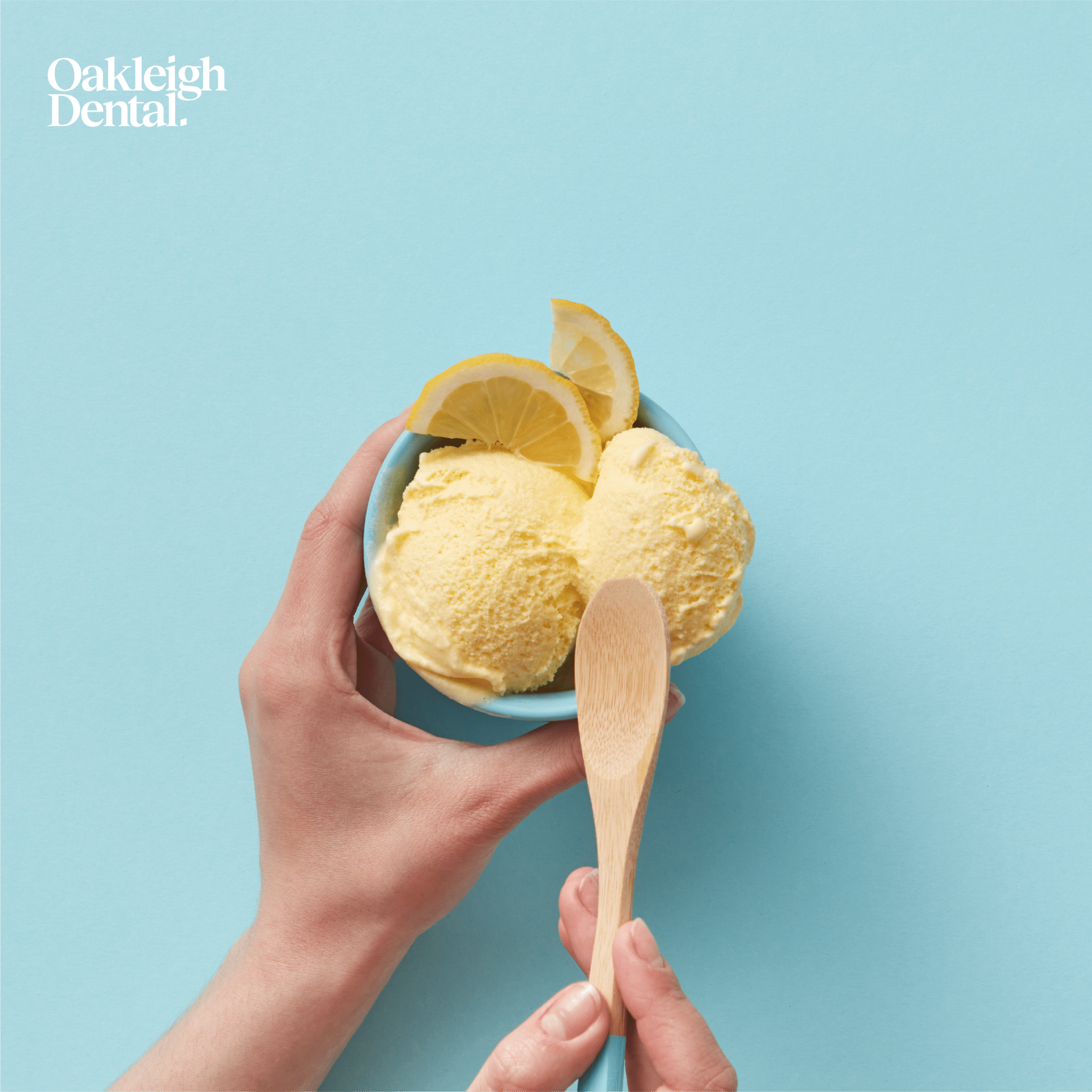What Can I Eat After Wisdom Teeth Extraction?
The days after wisdom teeth removal require patients to be thoughtful about using their mouths to ensure wounds heal properly. We teach patients how to clean their mouths, what to avoid and what issues to expect.
But most often, our patients’ main focus is knowing what to eat after getting wisdom teeth removed. Given how sensitive your mouth will be after an extraction, knowing what types of food are safe to eat, and which to avoid, can help you heal.
Why it’s important to eat well after wisdom teeth removal
After an extraction, you’ll likely experience swelling around your mouth and in your cheeks, making it difficult to eat normally. Ice packs and pain relief can be used to reduce pain, but it’s important to be smart with your eating. There are a number of other complications that you can encounter if you don’t take care with what you eat.
Dry socket
Part of the healing process is allowing a blood clot to form in the site of the extraction. This clot protects the underlying bone and nerves. However, clots fail to form when the area becomes disrupted, leading to a condition known as ‘dry socket’. Without the clot, your nerves are exposed and you can experience immense pain and discomfort. We treat dry socket by flushing the area and replacing a dressing. We recommend patients avoid eating foods likely to get stuck in small areas or irritate the blood clot.
Infections
If a dry socket goes untreated, the area often fills with food debris or bacteria. This worsens pain and swelling and allows infection. This compounds into other symptoms including fever, discharge and sensitivity. However, we can treat these with antibiotics and a thorough dental clean.

The best food to eat after wisdom teeth surgery
The initial day after wisdom teeth removal should only consist of very soft foods or liquids that require no chewing. These may include yoghurt, mashed potatoes and jelly. You can also have lukewarm soup so that the temperature doesn’t irritate your mouth.
After the first 24 hours, you may begin reincorporating semi-soft foods, like eggs, pasta, soft vegetables, chicken and beef. If your mouth is still very tender and sensitive, it might be worth sticking to soft foods for longer. Typically on the second or third day you should be able to transition to slightly harder foods like these.
Your best friend in terms of drinking will be water. Aside from all its usual health benefits, it will also keep your mouth clean and bacteria-free. Beyond that, smoothies are really popular because they allow you to combine different nutrients in a smooth, digestible way. However, don’t drink anything using straws — the sucking of a straw can dislodge the developing clot and delay healing.
Foods to avoid
As we’ve noted, for the first 24 hours you should avoid any foods that require chewing. Over the following 7 days, you can progressively incorporate more foods, but there are still some to avoid. Avoid eating foods that will negatively affect the extraction wound. These include spicy foods, crunchy and crumbly foods, and foods with grains and seeds.
In addition, it’s important to avoid anything that is overly hot in temperature, which can prolong swelling. Avoid drinking alcohol and soft drinks for at least the first five days after extraction, as well as caffeinated beverages, as these can disturb your teeth and mouth.

Wisdom teeth food timeline
It can be tough to keep track of when different foods are ok to eat after an extraction. To make it easier for you to know what food to eat after wisdom teeth removal, we’ve created a timeline to help you stay on track.
Day one
For the first two hours after the extraction, you should avoid eating anything at all. For the rest of the day, focus on liquidy substances including broths, yoghurt, ice-cream and soup. Nothing should exceed a lukewarm temperature. Augment all of this with a regular flow of water to stay hydrated.
Day two
You can begin adding some more soft foods like eggs and cottage cheese if your mouth’s sensitivity has begun to reduce. It is normal to still experience limited jaw movement and discomfort, so don’t rush to include these foods — it is entirely ok to continue having very smooth and soft meals.

Day three
By this point, your swelling should be reducing and you should be able to include semi-soft foods like mashed potatoes, pasta and soft vegetables. Avoid chewing or letting food rest on the affected side of your mouth so food particles do not stick in the wound and delay healing. Continue staying well hydrated with water, and potentially enjoy a smoothie or milkshake as long as you aren’t using a straw.
Day four
Your pain should be at a much more manageable and comfortable level at this stage, but it is still important to be careful with what you eat. People often go back to chewy foods as part of their normal diet, but this can just aggravate the swelling and pain again. Instead, opt for semi-soft foods, and re-add small quantities of chicken or beef as long as it is well-cooked and not overly chewy. Pulled pork is another great option.
Day five
From here, you can begin to reintroduce solid foods, but you should be guided by how your mouth feels and whether there is still pain or limited jaw movement. Similarly, if you begin to feel any pain while you are chewing, you should avoid solid foods and continue eating soft or semi-solid foods.
Beyond
Continue to pay attention to any pain or discomfort when you eat, and try only to eat foods that are comfortable. It can still be dangerous to chew aggressively near the extraction site, but everything will progressively return to normal and after about two weeks you should be able to return to your normal diet.
How to get food out of wisdom teeth holes
It is a common fear among patients that they will get food stuck in wisdom teeth holes. Eating only soft foods should help, but it’s also important to chew away from the site of extraction.
If you do find yourself with food lodged in the extraction area, a gentle saltwater or herbal tea rinse may help to dislodge it. However, we only recommend using these for the first 24 hours after the extraction process. Avoid swishing the liquid around vigorously in the mouth as this may dislodge the developing blood clot as well, and similarly do not spit but let it fall out of your mouth when done.

Making healthy choices
Following these guidelines and any recommendations provided by your dentist can ensure that your post-treatment experience is smooth and everything heals properly as soon as possible. Don’t try to rush it — the site of an extraction will take time to fully heal and any disruptions to that process will only make it more difficult and painful.
Our dentists can help you plan out the right post-treatment plan, including what kinds of food to eat and when. If you have any questions, don’t hesitate to reach out — we’re always here to help.


